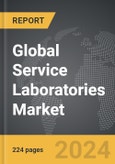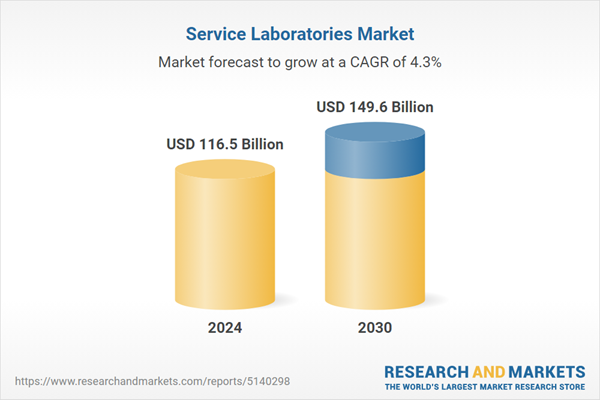The global market for Service Laboratories was valued at US$116.5 Billion in 2024 and is projected to reach US$149.6 Billion by 2030, growing at a CAGR of 4.3% over the analysis period 2024-2030. This comprehensive report provides an in-depth analysis of market trends, drivers, and forecasts, helping you make informed business decisions. The report includes the most recent global tariff developments and how they impact the Service Laboratories market.
Segments: Segment (Service Laboratories).
Geographic Regions/Countries: World; United States; Canada; Japan; China; Europe (France; Germany; Italy; United Kingdom; and Rest of Europe); Asia-Pacific; Rest of World.
The analysts continuously track trade developments worldwide, drawing insights from leading global economists and over 200 industry and policy institutions, including think tanks, trade organizations, and national economic advisory bodies. This intelligence is integrated into forecasting models to provide timely, data-driven analysis of emerging risks and opportunities.
Global Service Laboratories Market - Key Trends and Drivers Summarized
Why Are Service Laboratories Gaining Popularity Across Various Sectors?
Service laboratories are becoming increasingly popular across multiple industries due to the rising need for specialized testing, diagnostics, and analytical services. These laboratories offer a range of services, from clinical diagnostics and pharmaceutical testing to environmental analysis and food safety assessments. Companies and organizations are leveraging service laboratories to enhance their operational efficiency, reduce costs, and access specialized expertise and advanced equipment without investing in in-house capabilities. The pharmaceutical and biotechnology sectors, in particular, are major users of service laboratories, relying on them for preclinical and clinical trials, quality control, and regulatory compliance. Additionally, the increasing focus on personalized medicine and precision diagnostics is further driving the demand for advanced laboratory services, enabling tailored healthcare solutions and better patient outcomes.How Are Technological Innovations Shaping the Future of Service Laboratories?
Technological innovations are playing a pivotal role in shaping the future of service laboratories by improving accuracy, speed, and cost-effectiveness. The integration of advanced automation, artificial intelligence (AI), and machine learning (ML) technologies is revolutionizing laboratory workflows, enabling high-throughput screening, data analysis, and predictive diagnostics. Digital pathology, next-generation sequencing (NGS), and mass spectrometry are some of the cutting-edge technologies driving advancements in service laboratories. Moreover, the adoption of Laboratory Information Management Systems (LIMS) and cloud-based platforms is enhancing data management, collaboration, and compliance with regulatory standards. The focus on developing sustainable laboratory practices, such as reducing energy consumption and waste generation, is also gaining traction, driven by increasing environmental concerns and regulatory pressures.Which Market Segments Are Leading the Adoption of Service Laboratories?
The service laboratories market is segmented by type, application, end-user, and region. Types of service laboratories include clinical laboratories, environmental testing laboratories, food and beverage testing laboratories, and pharmaceutical and biotechnology laboratories, with clinical laboratories being the largest segment due to the high demand for diagnostic testing and pathology services. Applications of service laboratories span healthcare diagnostics, drug development, environmental monitoring, food safety, and forensic analysis, with healthcare diagnostics and drug development being the largest segments. End-users include hospitals, research institutes, government agencies, and commercial organizations, with hospitals and pharmaceutical companies being the major adopters due to their reliance on external laboratories for testing, validation, and compliance. Geographically, North America and Europe are the leading markets for service laboratories due to advanced healthcare infrastructure and stringent regulatory standards, while Asia-Pacific is emerging as a high-growth region driven by increasing healthcare investments, rising disease burden, and growing awareness of food safety and environmental issues.What Are the Key Drivers of Growth in the Service Laboratories Market?
The growth in the service laboratories market is driven by several factors, including the increasing demand for specialized testing and diagnostic services, advancements in laboratory automation and digital technologies, and the rising adoption of personalized medicine and precision diagnostics. The development of AI-powered, high-throughput screening, and predictive diagnostic tools is driving market adoption among pharmaceutical, biotechnology, and healthcare sectors. The emphasis on reducing operational costs, enhancing accuracy, and ensuring compliance with regulatory standards is expanding the market reach across food safety, environmental monitoring, and forensic analysis applications. The shift towards integrated, multi-disciplinary laboratory networks that offer end-to-end testing solutions is creating new opportunities for market growth. Additionally, the increasing investments in R&D for next-generation laboratory technologies, sustainable practices, and LIMS solutions are further supporting market expansion.Report Scope
The report analyzes the Service Laboratories market, presented in terms of units. The analysis covers the key segments and geographic regions outlined below.Segments: Segment (Service Laboratories).
Geographic Regions/Countries: World; United States; Canada; Japan; China; Europe (France; Germany; Italy; United Kingdom; and Rest of Europe); Asia-Pacific; Rest of World.
Regional Analysis
Gain insights into the U.S. market, valued at $31.3 Billion in 2024, and China, forecasted to grow at an impressive 4.0% CAGR to reach $23.7 Billion by 2030. Discover growth trends in other key regions, including Japan, Canada, Germany, and the Asia-Pacific.Why You Should Buy This Report:
- Detailed Market Analysis: Access a thorough analysis of the Global Service Laboratories Market, covering all major geographic regions and market segments.
- Competitive Insights: Get an overview of the competitive landscape, including the market presence of major players across different geographies.
- Future Trends and Drivers: Understand the key trends and drivers shaping the future of the Global Service Laboratories Market.
- Actionable Insights: Benefit from actionable insights that can help you identify new revenue opportunities and make strategic business decisions.
Key Questions Answered:
- How is the Global Service Laboratories Market expected to evolve by 2030?
- What are the main drivers and restraints affecting the market?
- Which market segments will grow the most over the forecast period?
- How will market shares for different regions and segments change by 2030?
- Who are the leading players in the market, and what are their prospects?
Report Features:
- Comprehensive Market Data: Independent analysis of annual sales and market forecasts in US$ Million from 2024 to 2030.
- In-Depth Regional Analysis: Detailed insights into key markets, including the U.S., China, Japan, Canada, Europe, Asia-Pacific, Latin America, Middle East, and Africa.
- Company Profiles: Coverage of players such as Cerium Labs, LLC, Danaher Corporation, EAG Laboratories, Hitachi High-Tech Corporation, Hitachi Ltd. and more.
- Complimentary Updates: Receive free report updates for one year to keep you informed of the latest market developments.
Some of the 44 companies featured in this Service Laboratories market report include:
- Cerium Labs, LLC
- Danaher Corporation
- EAG Laboratories
- Hitachi High-Tech Corporation
- Hitachi Ltd.
- Interstate Optical
- Nu Instruments Ltd.
- Tescan Orsay Holding, a. s.
- Zer Hitech
Tariff Impact Analysis: Key Insights for 2025
Global tariff negotiations across 180+ countries are reshaping supply chains, costs, and competitiveness. This report reflects the latest developments as of April 2025 and incorporates forward-looking insights into the market outlook.The analysts continuously track trade developments worldwide, drawing insights from leading global economists and over 200 industry and policy institutions, including think tanks, trade organizations, and national economic advisory bodies. This intelligence is integrated into forecasting models to provide timely, data-driven analysis of emerging risks and opportunities.
What’s Included in This Edition:
- Tariff-adjusted market forecasts by region and segment
- Analysis of cost and supply chain implications by sourcing and trade exposure
- Strategic insights into geographic shifts
Buyers receive a free July 2025 update with:
- Finalized tariff impacts and new trade agreement effects
- Updated projections reflecting global sourcing and cost shifts
- Expanded country-specific coverage across the industry
Table of Contents
I. METHODOLOGYII. EXECUTIVE SUMMARY2. FOCUS ON SELECT PLAYERSIII. MARKET ANALYSISIV. COMPETITION
1. MARKET OVERVIEW
3. MARKET TRENDS & DRIVERS
4. GLOBAL MARKET PERSPECTIVE
UNITED STATES
CANADA
JAPAN
CHINA
EUROPE
FRANCE
GERMANY
ITALY
UNITED KINGDOM
REST OF EUROPE
ASIA-PACIFIC
REST OF WORLD
Companies Mentioned (Partial List)
A selection of companies mentioned in this report includes, but is not limited to:
- Cerium Labs, LLC
- Danaher Corporation
- EAG Laboratories
- Hitachi High-Tech Corporation
- Hitachi Ltd.
- Interstate Optical
- Nu Instruments Ltd.
- Tescan Orsay Holding, a. s.
- Zer Hitech
Table Information
| Report Attribute | Details |
|---|---|
| No. of Pages | 224 |
| Published | April 2025 |
| Forecast Period | 2024 - 2030 |
| Estimated Market Value ( USD | $ 116.5 Billion |
| Forecasted Market Value ( USD | $ 149.6 Billion |
| Compound Annual Growth Rate | 4.3% |
| Regions Covered | Global |









